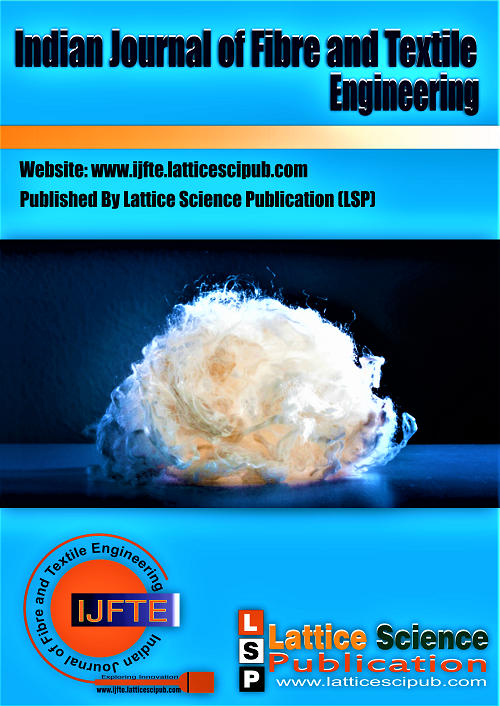Optimization of Fabric Parameters on the Effectual Properties of Nonwoven Industrial Wipes Blend using Response Surface Methodology
Main Article Content
Abstract
Development in technical in textiles especially nonwoven fabrics/materials offers a brightly limitless prospect for the textile industry to lance into an extensive series of applications ranging from earth to space and beyond. Nonwoven industrial wipes fabric properties are the result of production technology and the combination of fabric constructional parameters. This work looks into the effect of fabric parameters on the desired properties of nonwoven industrial wipes fabricated by needle punching technique with the utilization of viscose and polyester fibres and their blends using RSM. The basic and essential characterization techniques to obtain information related to physiochemical properties of the nonwoven fabrics, using analytical investigation techniques have been evaluated. The results obtained established that the fabric parameters have a great influence on the nonwoven fabric structure and ultimately its properties. The result revealed that higher content of PET fibres led to a reduction in the vertical wicking rate, but better rising height can be achieved at samples made from 100 % of viscose fibres. Also, the influence of pore size and porosity largely influenced the fabric characteristics. The fibre volume fraction on the strength of nonwovens has been studied. The fabricated wipes present themselves as potential candidates for highly absorbent industrial wipes.
Downloads
Article Details

This work is licensed under a Creative Commons Attribution-NonCommercial-NoDerivatives 4.0 International License.
How to Cite
References
N. Mao, S. J. Russell. (2015). In book: Textiles and Fashion: Fibre to Fabric. Textiles and Fashion, 307–335. doi:10.1016/b978-1-84569-931-4.00013-1. [CrossRef]
V. Edwards, P. Sawhney, A. Bopp, A. French, R. Slopek, M. Reynolds, … Montalvo, J. (2015). An Assessment of Surface Properties and Moisture Uptake of Nonwoven Fabrics from Ginning By-products. Cellulose - Fundamental Aspects and Current Trends. doi:10.5772/61329. [CrossRef]
V. Soukupova, L. Boguslavsky, D. R. AnandJiwala. (2007). Studies on the Properties of Biodegradable Wipes made by the Hydroentanglement
Bonding Technique. Textile Research Journal, 77(5), 301–311.[CrossRef]
A. Watzl, J. Eisenacher, B. D. Gillespie. Nonwoven & Lifestyle –Spunlaced and Airlaid Nonwovens for Medical –Surgical – Health Care– Personal Care – Hygiene, in Proc.2001 Beltwide Cotton Conference,National Cotton Councilof America, Memphis, TN, USA, 698–701.
C. R. Frederic. (2004). Battle of Industrial Wipes, Nonwoven Industry,56–65.
G. Derringer, R. Suich. (1980). Simultaneous optimization of severalresponse variables. Journal of Quality Technology, 12(4), 214-219.[CrossRef]
J. T. Orasugh, N. R. Saha, G. Sarkar, D. Rana, R. Mishra, D. Mondal, S.K. Ghosh, D. Chattopadhyay. (2018a). Synthesis of methylcellulose/cellulose nano-crystals nanocomposites: Material properties and study of sustained release of ketorolac tromethamine.
Carbohydrate Polymers, 188, 168-180. [CrossRef]
J. T. Orasugh, N. R. Saha, D. Rana, G. Sarkar, M. M. R. Mollick, A.Chattopadhyay, B. C. Mitra, D. Mondal, S. K. Ghosh, D.Chattopadhyay. (2018b). Jute cellulosenano-fibrils/hydroxypropylmethylcellulose nanocomposite: a novelmaterial with potential for application in packaging and transdermal drug delivery system. Industrial Crops and Products, 112, 633-643. [CrossRef]
N. Mao, S. J. Russell. Capillary pressure and liquid wicking in three-dimensional nonwovenmaterials. Journal of Applied Physics, 104, 034911 (2008). [CrossRef]
AS 2836.4-1998 Methods of Testing Surgical Dressings & Surgicaln Dressing Materials– Method for the Determination of Size.
P. W. Chuleigh. (1983). Image formation by fibres and fibre assemblies, Textile Research Journal, 54, 813. [CrossRef]
R. Chhabra. (2003). Nonwoven Uniformity – Measurements Using Image Analysis, International Nonwovens Journal, 12(1), 43–50.
[CrossRef]
J. W. S. Hearle, P. J. Stevenson. (1963). Nonwoven fabric studies, part 3: The anisotropy of nonwoven fabrics. Textile Research Journal, 33,
–888. [CrossRef]
D. P. Dubrovski, M. Brezocnik. (2016). Porosity and nonwoven fabric vertical wicking rate. Fibers and Polymers, 17(5), 801–808.
DOI:10.1007/s12221-016-6347-5. [CrossRef]
H. H. Epps, K. K. Leonas. (2000). Pore Size and Air Permeability of Four Nonwoven Fabrics. International Nonwovens Journal, os-9, 2.
https://doi.org/10.1177/1558925000OS-900215. [CrossRef]
E. Çinçik, E. Koç. (2011). An analysis on air permeability of polyester/viscose blended needle-punched nonwovens. Textile
Research Journal, 82(5), 430–442. [CrossRef]
N. Gobi, S. Evangelin, R. Kasthuri, D. Nivetha. (2019). Multilayer nonwoven fabrics for filtration of micronand submicron particles.
Journal of Textile Engineering and Fashion Technology, 5(2):81‒84. [CrossRef]
P. Soltani, M. S. Johari, M. Zarrebini. (2015). 3D Fiber Orientation Characterization of Nonwoven Fabrics using X-ray Micro-computed
Tomography. World Journal of Textile Engineering and Technology, 1, 41-47.
E. M. Yüksekkaya, M. Tercan, G. Doğan, (2010). Filter media research: Fabric reinforcement of nonwoven filter cloths. Filtration &
Separation, 47(3), 36–39. [CrossRef]
M. T. Wright, M. C. Carr, A. C. Grant, V. Lilladhar, J. S. Russell. (2015). Strength of hydroentangled fabrics manufactured from photo-irradiated poly para-phenyleneterephthalamide (PPTA) fibres. Polymer Degradation and Stability, 121, 193–199. doi:10.1016/j.polymdegradstab.2015.08.017[CrossRef]
P. K. Patnaik, R. T. P. Swain, K. S. Mishra, A Purohit, S. Biswas. (2020). Recent developments on characterization of needle-punched
nonwoven fabric reinforced polymer composites – A review. Materials Today: Proceedings. DOI:10.1016/j.matpr.2019.12.086[CrossRef]
J-H. Li, C-J. Hsieh, W-C. Lou, T-C. Hsieh, J-Y. Pan, Y.-J., Hsing, W.-H., H-J. Lin. (2016). Needle-punched thermally-bonded eco-friendly nonwoven geotextiles: Functional properties. Materials Letters, 183, 77–80. DOI:10.1016/j.matlet.2016.07.074[CrossRef]
H. H. Epps, K. K. Leonas. (2002). GA. Pore Size and Air Permeability of Four Nonwoven Fabrics. DOI:
https://journals.sagepub.com/doi/pdf/10.1177/1558925000OS-900215
A. Zaman, J. T. Orasugh, P. Banerjee, S. Dutta, M. S. Ali, D. Das, A. Bhattacharya, D. Chattopadhyay. (2020). Facile one-pot in-situ synthesis of novel graphene oxide-cellulose nanocomposite for enhanced azo dye adsorption at optimized conditions. Carbohydrate Polymers, 2020, 116661. [CrossRef]
ASTM D737-96 Test Method for Air Permeability of Textile Fabrics. 26. BS EN ISO 9237:1995 Textiles. Determination of the permeability of
fabrics to air; ISO/DIS 9073-15: 2005 Textiles – Test methods for nonwovens – Part 15: Evaluation of air permeability.





